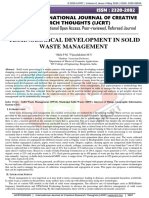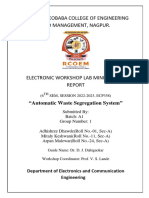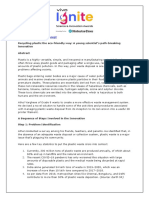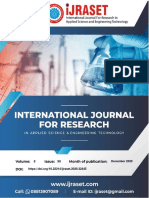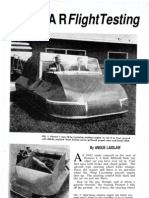Waste Management Using Reward System: Test Engineering and Management January 2021
Waste Management Using Reward System: Test Engineering and Management January 2021
Uploaded by
DevangCopyright:
Available Formats
Waste Management Using Reward System: Test Engineering and Management January 2021
Waste Management Using Reward System: Test Engineering and Management January 2021
Uploaded by
DevangOriginal Title
Copyright
Available Formats
Share this document
Did you find this document useful?
Is this content inappropriate?
Copyright:
Available Formats
Waste Management Using Reward System: Test Engineering and Management January 2021
Waste Management Using Reward System: Test Engineering and Management January 2021
Uploaded by
DevangCopyright:
Available Formats
See discussions, stats, and author profiles for this publication at: https://www.researchgate.
net/publication/348390926
Waste Management Using Reward System
Article in Test Engineering and Management · January 2021
CITATIONS READS
0 1,045
3 authors, including:
Mallikarjuna Shastry Pm
Reva University
13 PUBLICATIONS 4 CITATIONS
SEE PROFILE
All content following this page was uploaded by Mallikarjuna Shastry Pm on 11 January 2021.
The user has requested enhancement of the downloaded file.
May - June 2020
ISSN: 0193-4120 Page No. 4935-4938
Waste Management Using Reward System
1
Ganesh Prasad Rao, 2Harsha Vardhan M N, 3Mallikarjuna Shastry P.M
1,2,3
School of Computing & Information Technology, REVA University, Bengaluru, 560064, India
1
r16cs134@cit.reva.edu.in, 2r16cs153@cit.reva.edu.in, 3mallikarjunashasty@reva.edu.in
Article Info Abstract
Volume 83 The planet has undergone tremendous stress since the beginning of the
Page Number: 4935-4938 industrial revolution, the invention of plastic, boosted the
Publication Issue: manufacturing industries. Plastic is inexpensive, versatile, strong,
May - June 2020
flexible, waterproof non porous. Due to this, plastic is used on a large
scale to develop and manufacture even the most basic products such as
plastic covers, bottles to space equipment. The success and dominance
of plastic as a goto material for varied commercial products created
concerns of environmental pollution. Currently, plastic pollution is one
of the major threats to the environment and wildlife. Recycling is opted
as a measure to reuse and repurpose plastic. The main challenge of the
scenario boils down to the collection of plastic, governments have to
deal with littered plastic which proves to be difficult. This paper
Article History addresses this problem of plastic waste management and proposes a
Article Received:19 November 2019 solution using IoT and introduces the concept of rewards which will
Revised: 27 January 2020 motivate proper waste disposal.
Accepted: 24 February 2020
Publication: 16 May 2020 Keywords: IoT, Waste management, reward system, Smart City
1. Introduction the upcoming 4-5 years will undoubtedly decide the fate
The advent of the Internet marked a new era in the history of the planet. One of the prevailing problems of humanity
of human civilization, since then the Internet has become which needs immediate attention turns out to be Waste
one of the driving forces of innovation and also a basic Management, more specifically plastic waste
need for commoners. The possibilities of the Internet has management. Waste in general is any material substance
led to the development of the Internet of Things(IoT), that cannot be used or doesn’t add any economic value to
where almost anything can be connected to the Internet. its owner, broadly waste is categorized as wet waste and
This enabled companies to introduce “smart” devices or dry waste[3]. Usually, most of the wet waste and some of
gadgets that are connected to the Internet [1]. World as the dry waste is naturally biodegradable, other human
one knows today is coming up with new fascinating strategies to manage waste are recycling, animal feeding,
technologies that make human life easier and smarter fermenting, landfill burning, and composting [2]. A large
with each passing day. Scientific advancement is part of dry waste is made of plastic, and from the above
remarkable, in fact, the world has witnessed immense strategies, recycling of plastic is the most sensible way to
progress in the last few decades more than the combined handle it. Even so, the collection of plastic waste proves
history of all human civilizations and there’s no stopping to be a deal breaker.
it but there’s a dark side to it as well, in the same last few This paper proposes a method for efficient collection
decades, humans have been polluting the earth without of recyclable waste, it also discusses how the system can
thinking of the consequences - Global Warming, Climate be used to motivate ethical disposing of recyclable plastic
Change, Unfertile dead lands, ocean pollution and more. waste. This paper will discuss the management of plastic
It is forgotten that the present generation is not the last waste, which plays a major role in pollution. The concept
on this planet and not the only life to thrive on it. of rewards is used to motivate proper disposal of plastic
The reasons for pollution is a lengthy list, few of waste.
them to name - fossil fuel combustion, methane emission Paper is organised as follows, in Section 2, literature
due to livestock, overpopulation, poor waste survey is discussed. Section 3 presents the proposed
management, plastic waste dumping, over exploitation of system, Section 4 presents the results of the model.
natural resources etc.,. Measures taken against these in Section 5 concludes the paper and Section 6 discusses the
future enhancements for the project.
Published by: The Mattingley Publishing Co., Inc. 4935
May - June 2020
ISSN: 0193-4120 Page No. 4935-4938
2. Literature Survey
There have been several researches on implementing IoT
solutions for waste management, In [1] a model for a
smart dustbin is proposed where the dustbin is interfaced
with a microcontroller equipped with IR/ultrason and
weight sensors, It also suggests a website to display the
information of the garbage, such as level of the garbage
and the weight of the garbage. When the garbage is at
threshold level, and when the dustbin is full, the
information is sent to the website.
HN Saha et al. [2] points out that poor management
of waste has a direct effect on the global environment,
leading to various kinds of pollution and long-term health
ailments, this results in indirect implications on the
economy and growth potential. Hence it is necessary to
propose innovative solutions for waste collection and
Figure 2: Block Diagram of the waste system
recycling.
In [3] SA Mahajan et al. said that managing waste
can be done by planning, collecting, transporting ,
treating, recycling and disposing of waste with
monitoring and regulation. The author also suggests that
the current ways of collecting waste and managing it is
not efficient.
Gopal Kirshna Shyam, Sunilkumar S. Manvi and
Priyanka Bharti [4] propose a smart system of efficient
waste collection by authorities based on level of waste in
the dustbin using IoT and Machine learning analysis of
waste data, this analysis allows for optimised collection
routes for workers.
In this paper we propose the concept of rewards to
motivate people in adopting ethical waste disposing
practices. The concept of rewards will drive people to
dispose of waste in the dustbin.
3. Proposed system
A systematic methodology is adopted in building the
project. Rewarding any user who disposes recyclable
waste is the main aspect of this project.
Figure 1: Block Diagram of the waste system hardware
Figure 3: Flow chart of the project
Figure 1 shows the basic components of the trash
bin. Each trash bin is given a unique id which is encoded The above flow chart indicates the entire flow of the
as QR code. The Trash bins also have a dedicated system.
microcontroller (NodeMCU) to manage the sensors on Figure 3 depicts the flow control, the user, using the
board (Load Sensor, Ultrasonic Level Sensor) and client application scans the QR code on the trash bin, a
synchronise the data with the server. Figure 2 illustrates session is set for a limited time between the user and the
the complete system architecture, the trash bin updates trash bin, plastic is disposed within the session expiry
any changes in the weight to the server, the user time, the weight of the plastic disposed is updated to the
establishes a session with the trash bin by scanning the user in real-time and reward points are awarded based on
QR code. the weight.
Published by: The Mattingley Publishing Co., Inc. 4936
May - June 2020
ISSN: 0193-4120 Page No. 4935-4938
The Flask Server handles incoming data from the and a time limited session is established to dump the
Trash Bin and updates the database.. The server also waste.
handles user management functions and reward
calculation. 4.2. Weight Calculation
The reward is computed as, assuming 2 points is The weight changes in the dustbin is continuously
awarded for each 100g of plastic disposed: monitored by the NodeMCU using hx711 load amplifier.
(1) Amount of disposed weight is calculated as,
3.1. Specifications
1) Load Sensor: Load Sensor is used to detect the weight
of the garbage in the bin. The measured weight is sent to 4.3 Reward Assignment
the microcontroller(NodeMCU).The load sensor that is
being used can measure according to kitchen scale. When the waste was disposed within the session expiry,
2) Ultrasonic sensor: Here it is used to detect the level of the client is rewarded based on the amount of plastic
plastic waste in the trash bin.The sensor uses distance to weight of dumped.
measure the level. The distance between the sensor and
the garbage level computes the level of waste. 4.4 Average plastic Waste Collected
The sensor gets the distance by emitting ultrasonic waves Figure 4 depicts the trend of average plastic waste
and computes the time taken for the waves to send and disposed (in grams) by each individual every week for a
receive. 40Hz is the working frequency of an ultrasonic period of 12 weeks. Figure 12 shows a significant
sensor. increase in the amount of plastic disposed every week.
3) NodeMCU: NodeMCU is a micro controller unit with
ESP8266 Chip for Wifi capabilities. It is handy for rapid
prototyping of IoT projects which need wireless
connection or interfacing with Wifi. It is used to collect
and send weight data from the waste bin to the server in
this project.
3.2. Modules
1) Weight Calculation: The weight of the waste is
calculated using load sensors connected to the hx711
which is connected to the nodemcu.
2) QR Code: The QR code plays an important part in the
system by giving each trash bin a unique identity. The Figure 4: Weight of the waste disposed of by a single user
user needs to scan the QR code before depositing waste in
the bin. Figure 5 depicts the linear increase of average waste
3) Server: A Python-Flask Server, used to handle all the collected in kilograms by the trash bins over a period of
incoming requests from trash bins and the clients. The 12 weeks.
weight updation and reward calculation is also handled by
this server.
4) Reward Calculation: The criteria for reward
calculation is based on the deployment scenario. For the
purpose of this project reward calculation is done using
(1).
5) Database Connection: An online database is used to
store user and waste related data. In this model, mongoDb
is used to serve this purpose.
6) User Interface: An android application is made for the
user to interact with the reward points and mainly scan
the QR code present on the trash bin.
4. Results and Discussion Figure 5: Weight of the waste disposed of by all users
4.1. Initial Connection
The dustbin is deployed and a connection is established 5. Conclusion
with the server. The client application scans the QR code There are many innovative solutions for the problem of
waste management. These solutions tend to be at their
Published by: The Mattingley Publishing Co., Inc. 4937
May - June 2020
ISSN: 0193-4120 Page No. 4935-4938
best only when the plastic is properly disposed of. The
proposed concept of rewards motivate people to be
conscious of ethical plastic usage and disposal. Thus
enabling municipalities to manage the disposed waste
efficiently. The rewards could be customized based on
the deployment scenario.
6. Future Work
Future scope includes the possibility of extending the
system with a blockchain ledger to track the waste from
its source to its recycling destination, as done in many
supply chain solutions. The data from this can be
presented to the users as interesting statistics such as how
is the plastic recycled? where is it recycled? what is it
recycled as? This ensures proper usage of dustbins and
trash bins to dispose of plastic waste, and also reduces
public littering.
7. Acknowledgment
We would like to thank our parents for their continuous
support and encouragement to pursue the idea.
The authors would like to thank Dr.Mallikarjuna
Shastry P.M for guiding and motivating us with the
project.
We would like to thank the director, school of
computing and information technology, Dr.Sunilkumar
Manvi for his support.
We would like to thank the faculties of the school of
computing and information technology and our friends
for their encouragement.
References
[1] SS Navghane, MS Killedar, VM Rohokale “IoT
based smart garbage and waste collection bin”
International Journal of Advanced Engineering
Research and Science (IJAERS) Volume 5,
Issue 5, May 2016.
[2] HN Saha, S Auddy, S Pal, S Kumar “Waste
management using Internet of Things (IoT)”
DOI:10.1109/IEMECON.2017.8079623
Conference: Industrial Automation and
Electromechanical Engineering Conference
(IEMECON), 2017 8th Annual.
[3] SA Mahajan, A Kokane, A Shewale, M Shinde
“Smart Waste Management Systems”
International Journal of Advanced Engineering
Research and Science (IJAERS) Vol-4, Issue-4,
Apr-2017.
[4] Gopal Kirshna Shyam, Sunilkumar S. Manvi,
Priyanka Bharti “Smart Waste Management
using Internet-of-Things(IoT)” Second
International Conference On Computing and
Communications Technologies (ICCCT 17)
2017.
Published by: The Mattingley Publishing Co., Inc. 4938
View publication stats
You might also like
- Historical Beam SectionsDocument77 pagesHistorical Beam SectionsMohammed Hafiz100% (1)
- Loudon Organic Chemistry Chapter 14Document32 pagesLoudon Organic Chemistry Chapter 14JohnNo ratings yet
- An Approach To Smart Waste Segregation Using IOT - Formatted PaperDocument10 pagesAn Approach To Smart Waste Segregation Using IOT - Formatted PapercharanssitNo ratings yet
- IJCRT2005505Document4 pagesIJCRT2005505Niva R ChandraNo ratings yet
- EcoMamoni Modern Technologies For Waste ManagementDocument12 pagesEcoMamoni Modern Technologies For Waste Managementg13630173No ratings yet
- 1 s2.0 S2666285X22000577 MainDocument4 pages1 s2.0 S2666285X22000577 MainLinhNo ratings yet
- 3BS 05 Form 2 SAN JUANDocument8 pages3BS 05 Form 2 SAN JUANSi KatotoyNo ratings yet
- A Collaborative Application For Assisting The Management of Household Plastic Waste Through Smart Bins - A Case of Study in The PhilippinesDocument24 pagesA Collaborative Application For Assisting The Management of Household Plastic Waste Through Smart Bins - A Case of Study in The PhilippinesNyanshe StarkNo ratings yet
- Czekala, 2023Document14 pagesCzekala, 2023Muhammad Aslam MusyafaNo ratings yet
- Smart Dustbin ReportDocument29 pagesSmart Dustbin ReportAkshay bypNo ratings yet
- Sensors 22 02340Document19 pagesSensors 22 02340duntonmaryclaireNo ratings yet
- Sensors 22 02340Document19 pagesSensors 22 02340Ricardo RodriguezNo ratings yet
- Final EcoSortDocument57 pagesFinal EcoSortBryan De GuzmanNo ratings yet
- Chapter 2 Battery Operated Trash BinDocument9 pagesChapter 2 Battery Operated Trash BinPrincess Joy BarelNo ratings yet
- Waste Segmentation Using Deep LearningDocument6 pagesWaste Segmentation Using Deep LearningInternational Journal of Innovative Science and Research TechnologyNo ratings yet
- Nalysis of A Smart Trash Bin Using State-Based Markov Model and ReliabiliDocument14 pagesNalysis of A Smart Trash Bin Using State-Based Markov Model and Reliabiliwaciy70505No ratings yet
- Final ThesisDocument77 pagesFinal ThesisReyna Jean Vallescas Ladrera - PerezNo ratings yet
- Project Final ReportDocument12 pagesProject Final ReportarpanmalewarNo ratings yet
- FinalDocument43 pagesFinalminrose073No ratings yet
- Endaya Mabitasan Gonzales Waste SegregatorDocument7 pagesEndaya Mabitasan Gonzales Waste Segregatormorningrize26No ratings yet
- IRJMETSTemplate (2) SWMDocument5 pagesIRJMETSTemplate (2) SWMyashgaikwad0075No ratings yet
- Anna University::Chennai - 600025: TEAM ID: PNT2022TMID25602Document47 pagesAnna University::Chennai - 600025: TEAM ID: PNT2022TMID25602Abel MathewNo ratings yet
- Smartbin (Final)Document6 pagesSmartbin (Final)Jandred MaminoNo ratings yet
- 1701-Article Text-4580-1-10-20230721Document6 pages1701-Article Text-4580-1-10-20230721Putri Azzahra DinantiNo ratings yet
- A Reliable and Robust Deep Learning Model For Effective Recyclable Waste ClassificationDocument13 pagesA Reliable and Robust Deep Learning Model For Effective Recyclable Waste ClassificationcsebitannaNo ratings yet
- Faculty of The College of Engineering Technology: A Project Development Study/Thesis Presented To TheDocument26 pagesFaculty of The College of Engineering Technology: A Project Development Study/Thesis Presented To Themarjvalenzuela31No ratings yet
- Smart Garbage Collection2Document1 pageSmart Garbage Collection2Balaji B SurendranNo ratings yet
- Ijreiss 4130 56414Document10 pagesIjreiss 4130 56414Dejen HaileslassieNo ratings yet
- These Are Section of A Literature Review Section of A Thesis That I Need To CompleteDocument9 pagesThese Are Section of A Literature Review Section of A Thesis That I Need To CompleteIdris AyoNo ratings yet
- Case Study Article ConceptDocument3 pagesCase Study Article ConceptUdit AnandNo ratings yet
- THE USE OF TRASH BINATOR TO DECREASE OVERFLOWING WASTE IN THE DLANHS COMMUNITY (AutoRecovered)Document23 pagesTHE USE OF TRASH BINATOR TO DECREASE OVERFLOWING WASTE IN THE DLANHS COMMUNITY (AutoRecovered)Ella BalladaresNo ratings yet
- Eco-Friendly IOT Based Waste Segregation and ManagementDocument3 pagesEco-Friendly IOT Based Waste Segregation and Managementsachuakm742003No ratings yet
- Smart Garbage Collection1Document1 pageSmart Garbage Collection1Balaji B SurendranNo ratings yet
- Paper 88Document12 pagesPaper 88234SHREERAM .SNo ratings yet
- Assignment GEO-103..Document5 pagesAssignment GEO-103..habib ullahNo ratings yet
- Energies 16 03504Document14 pagesEnergies 16 03504Dyuthi ThampanNo ratings yet
- 2891-Article Text-16906-2-10-20230717Document8 pages2891-Article Text-16906-2-10-20230717Andi ArnaNo ratings yet
- Waste Management Eco-Friendly MachineDocument12 pagesWaste Management Eco-Friendly MachineAmmiel PerezNo ratings yet
- Solid Waste Management and Utilization of BlockchainDocument54 pagesSolid Waste Management and Utilization of BlockchainFarheen AhmedNo ratings yet
- 1 SMDocument9 pages1 SMbdz157hkNo ratings yet
- Automatic Garbage Segregation and Management SystemDocument7 pagesAutomatic Garbage Segregation and Management SystemInternational Journal of Innovative Science and Research TechnologyNo ratings yet
- Smart Garbage Monitoring and Clearance System Using Internet of ThingsDocument6 pagesSmart Garbage Monitoring and Clearance System Using Internet of ThingsMukesh LavanNo ratings yet
- Waste Managemnet Using IOTDocument6 pagesWaste Managemnet Using IOTDhanashree YadavNo ratings yet
- PlasticDocument26 pagesPlasticAnonymous qh5UUGTNo ratings yet
- Era of Sustainability in Textile Industry A Study On Rising Concerns Towards Sustainable Fabrics in Indian FringeDocument8 pagesEra of Sustainability in Textile Industry A Study On Rising Concerns Towards Sustainable Fabrics in Indian FringeIJRASETPublicationsNo ratings yet
- 2020d Solidwastemgmt TEMDocument8 pages2020d Solidwastemgmt TEMHarshal GaikwadNo ratings yet
- Empowering Waste CollectionDocument30 pagesEmpowering Waste CollectionDaren ToridaNo ratings yet
- Edi Research PaperDocument3 pagesEdi Research PaperPratik DixitNo ratings yet
- IoT Based Solid Waste Management SurveyDocument26 pagesIoT Based Solid Waste Management SurveyNurin Insyirah ShafieeNo ratings yet
- 2018 Waste Sorting PDFDocument7 pages2018 Waste Sorting PDFyasinNo ratings yet
- 05-Keerthana 2021 J. Phys. Conf. Ser. 1969 012029Document8 pages05-Keerthana 2021 J. Phys. Conf. Ser. 1969 012029ushkas9No ratings yet
- A Review Study of E-Waste Management in India: October 2017Document5 pagesA Review Study of E-Waste Management in India: October 2017Madhura AbhyankarNo ratings yet
- The Use of Modern Technology in Smart Waste Management and Recycling - Artificial Intelligence and Machine LearningDocument17 pagesThe Use of Modern Technology in Smart Waste Management and Recycling - Artificial Intelligence and Machine LearningKashaf BakaliNo ratings yet
- Design For Sensor Based Waste Segregator SystemDocument10 pagesDesign For Sensor Based Waste Segregator SystemIJRASETPublicationsNo ratings yet
- Sustainability 16 01087Document23 pagesSustainability 16 01087marilyn monferoNo ratings yet
- Development of A Smart and Automated Waste Management SystemDocument4 pagesDevelopment of A Smart and Automated Waste Management SystemInternational Journal of Innovative Science and Research TechnologyNo ratings yet
- Background of The Study: Ilocos Sur National High School - Senior High SchoolDocument47 pagesBackground of The Study: Ilocos Sur National High School - Senior High Schoollapy tapyNo ratings yet
- MACBETH-MAIRCA Plithogenic Decision-Making On Feasible Strategies of Extended Producer's Responsibility Towards Environmental SustainabilityDocument18 pagesMACBETH-MAIRCA Plithogenic Decision-Making On Feasible Strategies of Extended Producer's Responsibility Towards Environmental SustainabilityScience DirectNo ratings yet
- Development of Solar Smart Waste Management System Using IOTDocument10 pagesDevelopment of Solar Smart Waste Management System Using IOTIJRASETPublicationsNo ratings yet
- RP 2Document9 pagesRP 2arpanmalewarNo ratings yet
- Bacterial Cellulose: Sustainable Material for TextilesFrom EverandBacterial Cellulose: Sustainable Material for TextilesNo ratings yet
- Recycled Polyester: Manufacturing, Properties, Test Methods, and IdentificationFrom EverandRecycled Polyester: Manufacturing, Properties, Test Methods, and IdentificationNo ratings yet
- I Situation Analysis Fiat CaseDocument6 pagesI Situation Analysis Fiat CaseCristobalColon888100% (1)
- TYDB-D172719DEH4-33FT2 8 Port Dual BeamDocument2 pagesTYDB-D172719DEH4-33FT2 8 Port Dual Beambudi wirahmiNo ratings yet
- KHSH-9MK6CZ R0 enDocument81 pagesKHSH-9MK6CZ R0 enmani_208eeNo ratings yet
- Ece Filter DesignDocument117 pagesEce Filter DesignShreedhar JainNo ratings yet
- Modul Ajar NarrativeDocument5 pagesModul Ajar Narrativehening.kartikaNo ratings yet
- 06) Breakdown of PricesDocument2 pages06) Breakdown of PricesYusufNo ratings yet
- Aircarflighttesting: by Angus LaidlawDocument3 pagesAircarflighttesting: by Angus LaidlawJimNo ratings yet
- PR1 Handout 4Document7 pagesPR1 Handout 4Celina BautistaNo ratings yet
- Marketing BUBBLE SHEETDocument14 pagesMarketing BUBBLE SHEETmoNo ratings yet
- 09 - Hastings - Relational Paradigms in Social MarketingDocument10 pages09 - Hastings - Relational Paradigms in Social MarketingLaura Gil VelardeNo ratings yet
- 13.05.29 Fedders Lloyed Corp For KUDGIDocument2 pages13.05.29 Fedders Lloyed Corp For KUDGIBasheer AbdulNo ratings yet
- 56 110 1 SM PDFDocument6 pages56 110 1 SM PDFindraNo ratings yet
- Zeros of Delayed Sampled Systems: Vladimir BondarkoDocument6 pagesZeros of Delayed Sampled Systems: Vladimir BondarkoИван ШуинNo ratings yet
- FORENSIC BallisticsDocument77 pagesFORENSIC BallisticsKhael Bureros100% (1)
- Kinley WaterDocument1 pageKinley WaternispoNo ratings yet
- Vydehi SchoolDocument3 pagesVydehi Schooli am me0% (1)
- My One Day MenuDocument14 pagesMy One Day Menusamantha laurenthNo ratings yet
- Precedent Case StudyDocument8 pagesPrecedent Case StudyPriti Shukla0% (1)
- Summary Note On Surampalem Reservoir SchemeDocument2 pagesSummary Note On Surampalem Reservoir SchemeSaiteja PanyamNo ratings yet
- Project On Ratio AnalysisDocument11 pagesProject On Ratio AnalysisSAIsanker DAivAMNo ratings yet
- 2023 Variations To The Rules of TennisDocument2 pages2023 Variations To The Rules of TennisMahda NoviantikaNo ratings yet
- LBZPC Carbopol-Silk Brochure TDS-947 2014 Hubcast FNLDocument4 pagesLBZPC Carbopol-Silk Brochure TDS-947 2014 Hubcast FNLOnesany TecnologiasNo ratings yet
- Checklist Baseline ReviewDocument4 pagesChecklist Baseline ReviewQueenie QuisidoNo ratings yet
- Maths X Mcqs Chapter 08 Trigonometric Identities Based QuestionsDocument23 pagesMaths X Mcqs Chapter 08 Trigonometric Identities Based QuestionssairfanbabaNo ratings yet
- AIS Manual 8126Document484 pagesAIS Manual 8126DenysadenisaNo ratings yet
- The Bluest BluesDocument1 pageThe Bluest BluesHemily Santa Ana MNo ratings yet
- Activity 5 - Simulator Trainees Copy Exercise - Deck - TijamDocument3 pagesActivity 5 - Simulator Trainees Copy Exercise - Deck - TijamJohn Dennis TijamNo ratings yet
- Cadbury Takeover - Inside StoryDocument8 pagesCadbury Takeover - Inside Story3bandhuNo ratings yet



